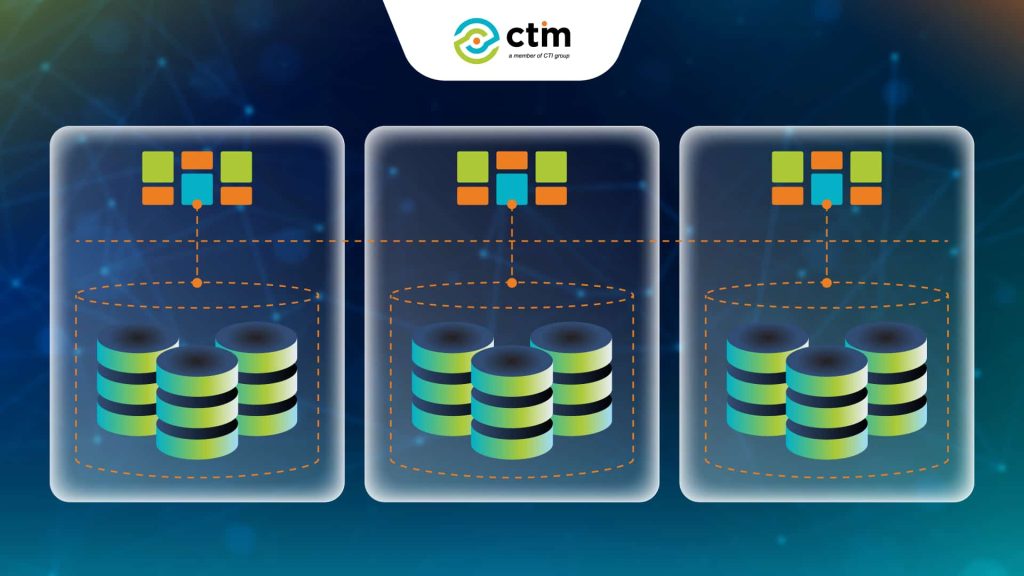Malaysia is entering a new digital era where data and technology drive economic growth. Under the MyDIGITAL Blueprint, the digital economy is set to drive innovation in E-commerce, fintech, and analytics. But as data volumes surge, traditional SQL databases — built for single servers — can’t keep up with today’s connected world.
To power this next phase of growth, businesses need a data foundation that’s as dynamic as the digital economy itself. That’s where Distributed SQL comes in, designed to distribute data across multiple nodes, it combines the reliability of relational databases with the scalability and resilience of cloud-native systems.
In this article, we’ll dive into how Distributed SQL helps Malaysia build a smarter, more connected digital future.
What is Distributed SQL?
Distributed SQL is a next-generation database architecture that extends traditional SQL beyond a single server. It distributes data across multiple nodes, often spanning regions or clouds, to deliver high availability, fault tolerance, and horizontal scalability. While maintaining full ACID compliance and the familiar SQL interface, it enables seamless scaling, automatic replication, and real-time consistency across all nodes.
In short, Distributed SQL combines the reliability of relational databases with the flexibility and performance of modern cloud-native systems built to handle globally distributed workloads without sacrificing transactional integrity.
Is Distributed SQL Really a New Kind of Database?
To put it simply, no.
It’s not an entirely new type of database, but rather the next evolution of the relational model. Distributed SQL builds on the trusted foundation of SQL while solving its biggest limitation: scalability. Emerging in the mid-2010s, it combines the strong consistency and ACID guarantees of traditional databases with the horizontal scale and resilience once limited to NoSQL systems.
How Distributed SQL Is Transforming the Database Landscape
The database world is evolving fast, and Distributed SQL sits at the center of that shift. Traditional SQL databases were built for a time when data lived in one place, on one server. But today’s applications demand something more: systems that can scale globally, stay online around the clock, and process data in real time. Distributed SQL answers that call, rethinking the relational model for a connected, cloud-native world.
What Sets SQL and Distributed SQL Apart?
Although both share the same relational foundation, SQL was built for a single server, while Distributed SQL was designed for a cloud-native world. The difference lies in scale, speed, and resilience.
| Feature | SQL | Distributed SQL
|
| Architecture | Single server | Multi-node, distributed
|
Scalability | Vertical | Horizontal
|
Availability | Prone to downtime | Always-on |
Consistency | Local ACID | Global ACID
|
Performance | Slows under load | Consistent at scale |
| Deployment | On-premises | Cloud-native |
Inside the Architecture of Distributed SQL
Distributed SQL isn’t just another database system, it’s an architecture built for speed, scale, and reliability. Unlike traditional databases that depend on a single server, Distributed SQL operates as a cluster of interconnected nodes that share the workload, replicate data, and maintain transactional consistency. This design allows applications to run seamlessly across regions, clouds, and even continents without compromising performance or availability.
To understand how it works, here are the key components that define Distributed SQL:
Query Layer
Processes SQL commands and distributes queries intelligently across nodes for optimal efficiency and speed.
Distributed Storage Layer
Automatically shards and replicates data to prevent bottlenecks and maintain high availability even during node failures.
Consensus Protocol (Raft)
Ensures all nodes agree on data updates, maintaining strong consistency and ACID compliance.
Load Balancing and Failover
Automatically reroutes traffic and recovers from node failures to keep operations running continuously.
Global Data Distribution
Places data closer to users, reducing latency and improving real-time access across multiple regions.
Observability and Monitoring
Offers insight into performance metrics, helping teams manage and fine-tune the system at scale.
How Does Distributed SQL Work?
To understand how this architecture delivers its power, let’s look at the two key layers that make it work.
Query Layer
The query layer is the interface between applications and the database. It processes SQL commands, optimizes queries, and coordinates how they’re executed across multiple nodes. This ensures that even complex operations like joins and transactions run smoothly, as if all the data lived in a single place.
The query layer maintains full SQL compatibility, allowing developers to use familiar syntax while benefiting from distributed performance.
Storage Layer
The storage layer is where the data actually lives. It automatically shards and replicates information across nodes, balancing workloads and ensuring no single point of failure. This layer handles data durability, synchronization, and distributed ACID transactions using consensus protocols like Raft.
The result is a storage engine that stays fast, consistent, and available, even when parts of the system fail.
Benefits of Distributed SQL
Distributed SQL delivers flexibility, combining the transactional strength of traditional SQL with the resilience and scalability of modern distributed systems. Here’s how Distributed SQL makes a real difference in practice.
- Elastic Scalability – Expands easily by adding nodes, so performance grows with your business.
- Continuous Availability – Recovers instantly from failures, ensuring operations never stop.
- Strong Consistency – Maintains accurate, ACID-compliant transactions across all regions.
- Low Latency – Keeps data close to users for faster access and real-time responsiveness.
- Cloud-Native Flexibility – Runs seamlessly across on-prem, hybrid, or multi-cloud environments.
- Operational Efficiency – Automates replication, failover, and scaling to reduce manual workload.
- Future-Ready Design – Supports digital transformation and global-scale applications.
How Distributed SQL Fuels Modernization and Cloud-Native Innovation
The push to innovate is driving Malaysian enterprises to build cloud-native applications, adopt microservices, and embrace data-intensive frameworks like edge computing and real-time analytics. These modern workloads demand flexibility, performance, and compliance — pressures that legacy, monolithic databases simply weren’t built to handle.
Resilient and Always Available
Distributed SQL delivers continuous uptime with rapid failover across nodes, zones, and regions, ensuring mission-critical services stay online even during system failures or maintenance.
Horizontally Scalable
It scales effortlessly to handle growing transaction volumes, users, and data loads — simply by adding nodes to a running cluster, without downtime or disruption.
Geographically Distributed
Distributed SQL replicates and partitions data across multiple regions, keeping it close to users to reduce latency and enhance real-time responsiveness.
Fully SQL-Compatible
It maintains ACID guarantees and full SQL functionality, allowing developers to use familiar tools while gaining the scalability of a distributed system.
Transactionally Consistent
Through coordinated writes and multi-version concurrency control, Distributed SQL ensures data remains accurate and consistent across all nodes.
Multi-Cloud Ready
It runs seamlessly across public, private, or hybrid clouds, supporting flexible deployments and helping organizations avoid vendor lock-in while optimizing cost efficiency.
Also Read: Cloud-Native Applications: The Key to Faster, Smarter Business Development
Why Distributed SQL Databases Are Becoming Essential?
Malaysia’s digital transformation is rapidly accelerating under initiatives like MyDIGITAL and the National Fourth Industrial Revolution (4IR) Policy.
As cloud adoption grows and more organizations migrate critical workloads online, traditional SQL databases — designed for centralized, single-server setups — are showing their limits. They struggle with the scale, speed, and availability that modern, data-driven systems demand.
Industries such as finance, E-commerce, and manufacturing now require infrastructure that can handle real-time transactions, multi-region access, and compliance with Malaysia’s data localization goals.
Getting Started with Distributed SQL
Adopting Distributed SQL begins with understanding your data architecture and identifying where scalability, uptime, and global performance matter most. Start small by deploying it alongside existing databases for high-traffic or mission-critical workloads then scale horizontally as your needs grow. With its SQL compatibility, developers can use familiar tools while gaining the benefits of distributed performance and resilience.
If you’re ready to explore this technology in action, you might want to look into YugabyteDB, an open-source Distributed SQL database built for cloud-native, globally distributed applications.
Why YugabyteDB Is Built for Malaysia’s Digital Transformation
YugabyteDB takes Distributed SQL to the next level, making it the perfect fit for Malaysia’s fast-evolving digital ecosystem. As enterprises modernize under the MyDIGITAL Blueprint and shift toward cloud-native infrastructure, YugabyteDB delivers the scale, reliability, and flexibility needed to power real-time, always-on applications. It combines the familiarity of PostgreSQL with seamless scalability across regions, ensuring consistent performance and automatic fault recovery even for mission-critical systems.
Flexible and open-source, YugabyteDB empowers Malaysian organizations to innovate without boundaries, maintaining compliance, improving uptime, and driving digital growth without the risks of vendor lock-in or legacy limitations.
Also Read: The Critical Role of ACID Transactions in Ensuring Data Integrity and Business Growth
What Everyone’s Asked About Distributed SQL
Can SQL Databases Be Distributed?
Yes. Distributed SQL extends the traditional relational model across multiple servers or nodes, enabling horizontal scalability and high availability while maintaining strong consistency and ACID guarantees.
What Are the Benefits of Distributed SQL?
Distributed SQL delivers enterprise-grade scalability, continuous uptime, and data resilience. It improves developer productivity, lowers operational costs, and powers real-time applications across multi-cloud and hybrid environments.
How Does Distributed SQL Work?
It operates as a single logical database across multiple nodes. Data is automatically replicated and distributed, allowing both read and write operations to occur simultaneously, ensuring performance and fault tolerance at scale.
When Should You Use Distributed SQL Instead of a Traditional Database?
Distributed SQL is ideal when your applications need to scale horizontally, stay online 24/7, or operate across multiple regions. If you’re building cloud-native platforms or replacing legacy RDBMS for modern workloads, Distributed SQL is the right fit.
Future-Proof Your Enterprise with CTM
CTM (Computrade Technology Malaysia) empowers enterprises to modernize and secure their digital infrastructure with YugabyteDB, the leading Distributed SQL database for cloud-native environments. As part of the CTI Group, CTM delivers end-to-end solutions that bring together identity security, AI governance, and data modernization, ensuring compliance, resilience, and scalability.
With deep regional expertise and a commitment to responsible innovation, CTM empowers Malaysian organizations to harness technologies like Distributed SQL and agentic AI to drive lasting business growth.
Ready to transform your data strategy? Contact CTM today and take the next step toward a smarter, future-ready enterprise.
Author: Danurdhara Suluh Prasasta
CTI Group Content Writer



